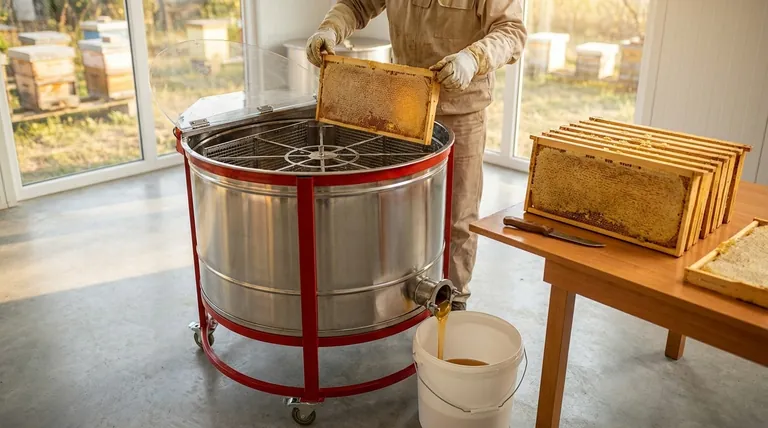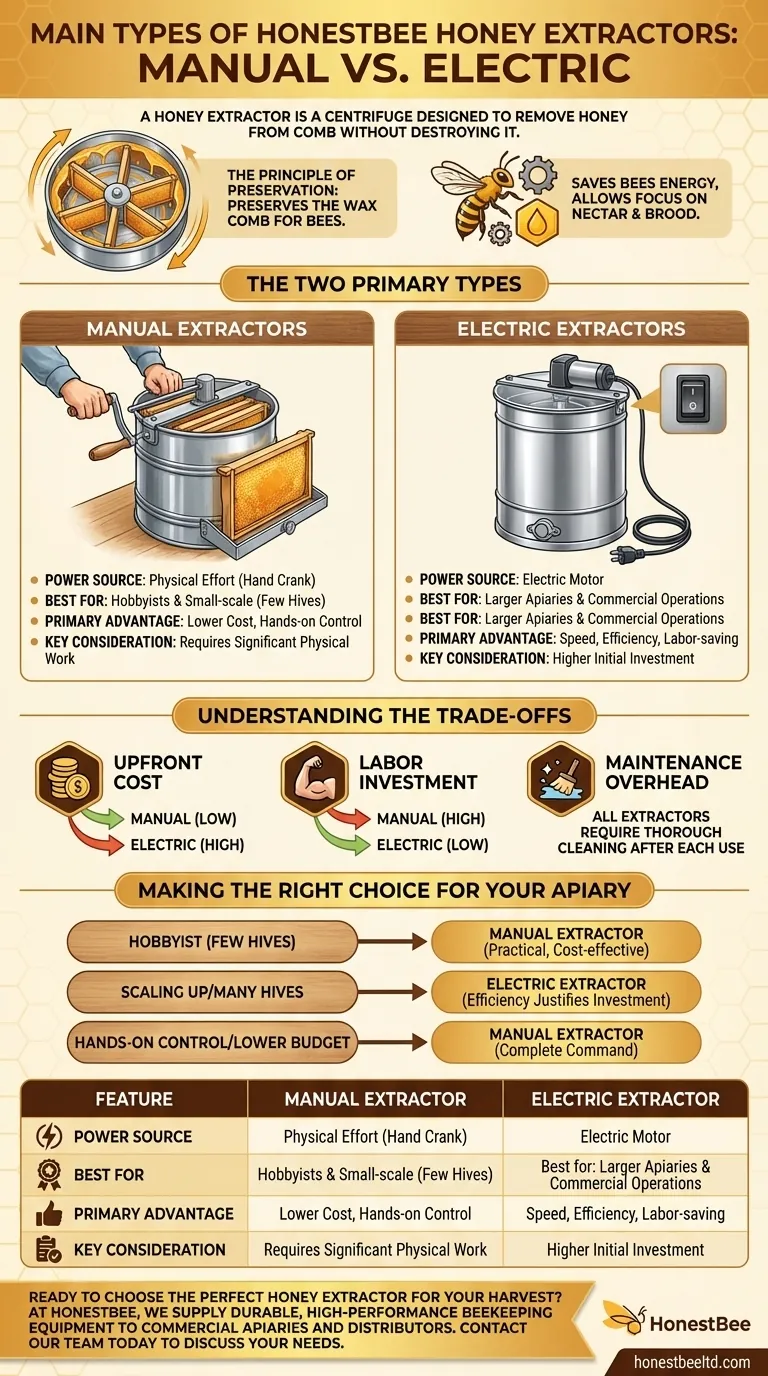At its core, a honey extractor is a centrifuge designed to remove honey from the comb without destroying it. The primary types available to beekeepers are distinguished by their power source: you can choose between a manual extractor, which you operate by hand, and an electric extractor, which uses a motor to automate the process.
The choice between a manual and electric honey extractor is a strategic decision based on the scale of your operation. It balances the upfront cost and hands-on control of a manual unit against the speed and efficiency of an electric model.

Why Use an Extractor at All?
The Principle of Preservation
A honey extractor is a mechanical device that spins frames of honeycomb inside a large drum. The centrifugal force slings the honey out of the cells and onto the drum's inner wall, where it drips down to a collection gate.
The single greatest benefit of this method is that it preserves the wax comb. The frames can be returned to the hive completely intact.
Supporting Your Bees
Bees expend a tremendous amount of energy and resources to produce wax and build out their comb. By returning the undamaged combs to them, you save the colony significant time and effort.
This allows the bees to focus their energy on other essential tasks, such as gathering more nectar and raising brood, leading to a stronger and more productive hive.
The Two Primary Extractor Types
Manual Extractors
A manual extractor is powered by physical effort, typically by turning a hand crank that spins the internal basket of frames.
These models are ideal for hobbyists or small-scale beekeepers with only a few hives. They offer greater control over the spinning speed and provide a more hands-on, traditional experience with the harvest.
Electric Extractors
Electric extractors use a motor to spin the basket, automating the most labor-intensive part of the process. They are the modern standard for beekeepers with larger apiaries.
Their primary advantage is efficiency and speed. An electric model can process a large number of frames much faster and with less physical strain than a manual one.
Understanding the Trade-offs
The Upfront Cost
All honey extractors represent an upfront investment. As a general rule, manual extractors are less expensive than their electric counterparts, making them a more accessible entry point.
The Labor Investment
The key trade-off is your time and effort. A manual extractor requires significant physical work, especially if you have many frames to process. An electric extractor automates this labor, saving you time and energy.
The Maintenance Overhead
Regardless of the type, every extractor must be thoroughly rinsed and cleaned after each use. This is a non-negotiable step to prevent contamination and maintain the equipment for future harvests.
Making the Right Choice for Your Apiary
The decision ultimately comes down to the size of your beekeeping operation and your personal goals.
- If you are a hobbyist with just a few hives: A manual extractor is often the most practical and cost-effective starting point, providing the core benefit of preserving comb.
- If you are scaling up or managing several hives: An electric extractor's efficiency will quickly justify the higher investment by saving you significant time and labor during the harvest.
- If your primary focus is hands-on control and a lower initial budget: A manual model gives you complete command over the extraction process at a more accessible price.
Ultimately, the right extractor is the one that allows you to harvest your honey efficiently while respecting the incredible work of your bees.
Summary Table:
| Feature | Manual Extractor | Electric Extractor |
|---|---|---|
| Power Source | Hand-cranked | Electric Motor |
| Best For | Hobbyists, Small-scale beekeepers | Larger apiaries, Commercial operations |
| Primary Advantage | Lower cost, Hands-on control | Speed, Efficiency, Labor-saving |
| Key Consideration | Requires physical effort | Higher initial investment |
Ready to choose the perfect honey extractor for your harvest?
At HONESTBEE, we supply durable, high-performance beekeeping equipment to commercial apiaries and distributors. Whether you're scaling your operation or need reliable wholesale gear, our extractors are built for efficiency and longevity.
Let us help you maximize your harvest. Contact our team today to discuss your needs and explore our wholesale-focused solutions.
Visual Guide

Related Products
- HONESTBEE 72 Frame Industrial Electric Honey Extractor for Beekeeping
- HONESTBEE 6 Frame Self Reversing Electric Honey Extractor for Beekeeping
- Professional 4 Frame Self Reversing Electric Honey Extractor for Beekeeping
- 8-Frame Electric Self-Reversing Honey Extractor Spinner for Commercial Honey Extraction Equipment
- Electric 8 Frame Honey Spinner Extractor Equipment for Beekeeping
People Also Ask
- What should a beekeeper do after extracting honey from supers? A Guide to Harvest Management
- Can a manual extractor be upgraded to an electric one? Save Labor & Boost Efficiency
- What is the energy consumption like for automatic honey extractors? Maximize Your Harvest Efficiency
- What are the advantages of automated honey extractors in terms of time efficiency? Boost Your Harvest Speed
- How is honey harvested from Langstroth hives? A Guide to Efficient, Comb-Preserving Extraction



















